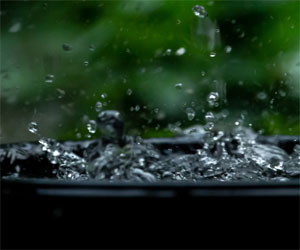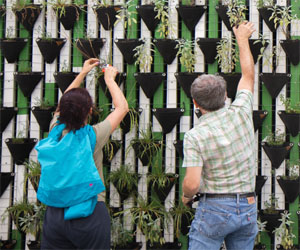


A Sustainable Solution For Water Scarcity

In an era marked by growing environmental concerns and increasing demands on our planet's resources, rainwater conservation stands out as a sustainable and practical solution to address the ever-looming issue of water scarcity. This age-old practice involves the collection, storage, and utilization of rainwater for various purposes, offering a multitude of environmental and economic benefits.
The Importance Of Rainwater Conservation
Water scarcity is a pressing global concern that affects millions of people, ecosystems, and industries. Many regions of the world are already experiencing the detrimental effects of water shortages, which can lead to droughts, crop failures, and even conflicts over dwindling water resources. Rainwater conservation addresses this issue by harnessing a natural resource that often goes underutilized.
The Collection Process
Rainwater conservation typically begins with the collection of rainwater from rooftops, pavements, or other surfaces. This water, known as runoff, is channeled through gutters and downspouts into storage tanks or cisterns. The collected rainwater can then be filtered and treated to make it suitable for various non-potable uses, such as watering gardens, flushing toilets, and washing vehicles. In some cases, rainwater can even be purified for drinking, further reducing the demand on municipal water supplies.
Environmental Benefits
One of the primary advantages of rainwater conservation is its positive impact on the environment. By capturing rainwater, we reduce the burden on natural water sources, such as rivers and lakes. This, in turn, helps protect aquatic ecosystems and maintains their biodiversity. Moreover, rainwater harvesting reduces soil erosion and minimizes the risk of flooding, as it diverts rainwater away from stormwater drainage systems.
Economic Benefits
Rainwater conservation also provides significant economic benefits. By using rainwater for non-potable purposes, homeowners and businesses can reduce their water bills, resulting in cost savings. In addition, governments and municipalities can save on infrastructure costs associated with water treatment and distribution.
Sustainable Urban Development
Rainwater conservation is especially relevant in urban areas, where impervious surfaces like concrete and asphalt prevent rainwater from seeping into the ground. As a result, urban areas often experience increased runoff and flooding. Implementing rainwater harvesting systems in cities can help manage stormwater and enhance sustainable urban development. Rooftop rainwater collection systems, for example, can be seamlessly integrated into building designs, providing an eco-friendly water source for landscaping and cooling systems.
Promoting Rainwater Conservation
To promote rainwater conservation, governments, non-profit organizations, and educational institutions can play a crucial role. They can provide incentives, rebates, or tax credits for installing rainwater harvesting systems, making it more affordable for individuals and businesses to adopt these practices. Public awareness campaigns can also educate people about the importance of rainwater conservation and how to implement it effectively.
Rainwater conservation offers a sustainable and eco-friendly approach to water management that addresses the critical issue of water scarcity. By reducing the reliance on traditional water sources, rainwater harvesting not only benefits the environment but also provides economic advantages to individuals and communities. As we face the challenges of a changing climate and increasing water demands, embracing rainwater conservation practices is a step toward a more sustainable and water-secure future.
Streamline Your Space And Simplify Your Life

1. Start Small
One of the most common mistakes when tackling clutter is trying to do too much at once. Start with a small area, like a drawer, a shelf, or a single closet. Completing one small area can give you a sense of accomplishment and motivate you to continue.
2. The One-Year Rule
If you haven't used or needed an item within the last year, consider whether it's truly necessary in your life. Apply the one-year rule when decluttering. If you haven't touched it in that time, it may be time to let it go.
3. Declutter By Category
Organize your decluttering efforts by category, not by room. For example, gather all your books, clothing, or kitchen items in one place and go through them systematically. This approach allows you to see the full extent of your possessions in that category.
4. Use The Four-Box Method
When decluttering a space, use the four-box method: one box for items to keep, one for items to donate, one for items to sell, and one for items to discard. This method helps you make decisions quickly and efficiently.
A Path To Sustainability And Well-Being

One of the fundamental principles of harmonious living is sustainability. This means using resources responsibly, minimizing waste, and conserving energy. Sustainable practices include reducing, reusing, and recycling, and making choices that have a lesser impact on the environment. By embracing sustainability, we reduce pollution, conserve biodiversity, and decrease our carbon footprint.
Compact Living With A Sustainable Touch
 Minimalism: Small footprint living encourages minimalism, a lifestyle that prioritizes quality over quantity and focuses on reducing clutter and material possessions. This approach often leads to a simpler, less stressful way of life.
Minimalism: Small footprint living encourages minimalism, a lifestyle that prioritizes quality over quantity and focuses on reducing clutter and material possessions. This approach often leads to a simpler, less stressful way of life.
Mobility: Some small footprint homes are built on wheels or designed for easy relocation. This provides homeowners with the freedom to move or travel as they wish, leading to a more mobile and adventurous lifestyle.
Energy Efficiency: Smaller spaces are easier to heat and cool, resulting in lower energy consumption. Many small footprint homes incorporate energy-efficient appliances, solar panels, and other sustainable technologies to further reduce their carbon footprint.
Community Living: Some small footprint housing developments encourage community living. Shared spaces and communal facilities foster social interaction and a sense of belonging among residents.
Innovation: The small footprint housing movement has spurred innovation in design and construction. Architects and builders are coming up with creative solutions to maximize space utilization, often incorporating modular and multi-functional furniture.
Embracing Self-Sufficiency And Sustainability
 Key Principles Of The Off-Grid Living Movement:
Key Principles Of The Off-Grid Living Movement:
Self-Sufficiency: At the heart of the off-grid living movement is the desire for self-sufficiency. Off-gridders aim to provide for their own basic needs, such as energy, water, and food, without relying on external infrastructure. They often employ renewable energy sources, such as solar panels and wind turbines, and use water collection and purification methods.
Sustainability: Sustainability is a cornerstone of off-grid living. This lifestyle emphasizes responsible and eco-conscious practices, from recycling and composting to sustainable agriculture and permaculture. Off-gridders typically seek to minimize their ecological footprint and reduce waste.
Resourcefulness: Off-grid living requires resourcefulness. Those who embrace this lifestyle must be creative and adaptive to overcome the challenges of living independently. They often build their homes using natural materials and repurpose everyday items to serve multiple purposes.
Connection With Nature: Off-grid living fosters a deep connection with the natural world. Many individuals who choose this lifestyle opt for remote locations, surrounded by the beauty of nature. They often forage for wild edibles, learn about local ecosystems, and live in harmony with the environment.
Minimalism: Minimalism is a common theme in off-grid living. By reducing the reliance on modern conveniences and material possessions, individuals often discover a simpler and more meaningful way of life.
Community: Contrary to the perception of complete isolation, many off-grid individuals form tight-knit communities where like-minded people come together to share knowledge, resources, and a sense of camaraderie. These communities enable collective development of sustainable practices.
Benefits Of The Off-Grid Living Movement:
Reduced Environmental Impact: Off-gridders significantly lower their environmental footprint. They use renewable energy sources, minimize waste, and employ sustainable agricultural methods, making their lifestyles more eco-friendly.
From Neglect To Paradise
 Assessment And Planning: The first step in any garden transformation is a thorough assessment of your space. Take a critical look at your garden, considering factors such as the current state of the plants, soil quality, layout, and potential issues like drainage problems. This assessment will help you identify the areas that need the most attention and guide your planning.
Assessment And Planning: The first step in any garden transformation is a thorough assessment of your space. Take a critical look at your garden, considering factors such as the current state of the plants, soil quality, layout, and potential issues like drainage problems. This assessment will help you identify the areas that need the most attention and guide your planning.
Clearing And Cleaning: For many neglected gardens, the first order of business is clearing away overgrown vegetation, weeds, and debris. This is the blank canvas upon which your transformation will unfold. Prune unruly branches, remove dead plants, and clear the ground to prepare it for new growth.
Soil Improvement: Healthy soil is the foundation of any successful garden. Assess your soil's condition and amend it as necessary. Adding organic matter like compost or well-rotted manure can improve soil structure and fertility, ensuring your plants have the nutrients they need to thrive.
Plant Selection: Choose plants that are well-suited to your local climate and growing conditions. Consider a mix of annuals, perennials, shrubs, and trees for a balanced and visually appealing garden. You can also incorporate native plants, which are adapted to the area and require less maintenance.
Garden Layout And Design: Carefully plan the layout of your garden. Consider elements like pathways, seating areas, and focal points. Create a design that not only enhances the beauty of your space but also ensures practicality and ease of maintenance.
Embracing Simplicity And Freedom
 2. Minimalist Living
2. Minimalist Living
The compact lifestyle often goes hand in hand with minimalist living. Minimalism is the art of living with less, focusing on quality over quantity, and savoring life's experiences over material possessions. This approach allows individuals to focus on what truly matters and brings joy, while reducing the overwhelming feeling of too much stuff.
3. Environmental Consciousness
Embracing a compact lifestyle also leads to a greater sense of environmental consciousness. Smaller living spaces mean reduced energy consumption, less waste, and a lower carbon footprint. This lifestyle choice can significantly contribute to a more sustainable and eco-friendly way of living.
4. Financial Freedom
Living a compact lifestyle can lead to significant financial benefits. With fewer expenses related to housing, maintenance, and possessions, individuals have the opportunity to save more, invest wisely, and gain financial freedom. This financial independence can open doors to new opportunities and experiences.
5. Freedom To Travel
A compact lifestyle often provides the freedom to travel and explore the world. With fewer material possessions tying you down, you can easily pick up and go, embracing a nomadic lifestyle or simply enjoying more frequent getaways. Travel becomes an essential part of experiencing life to the fullest.